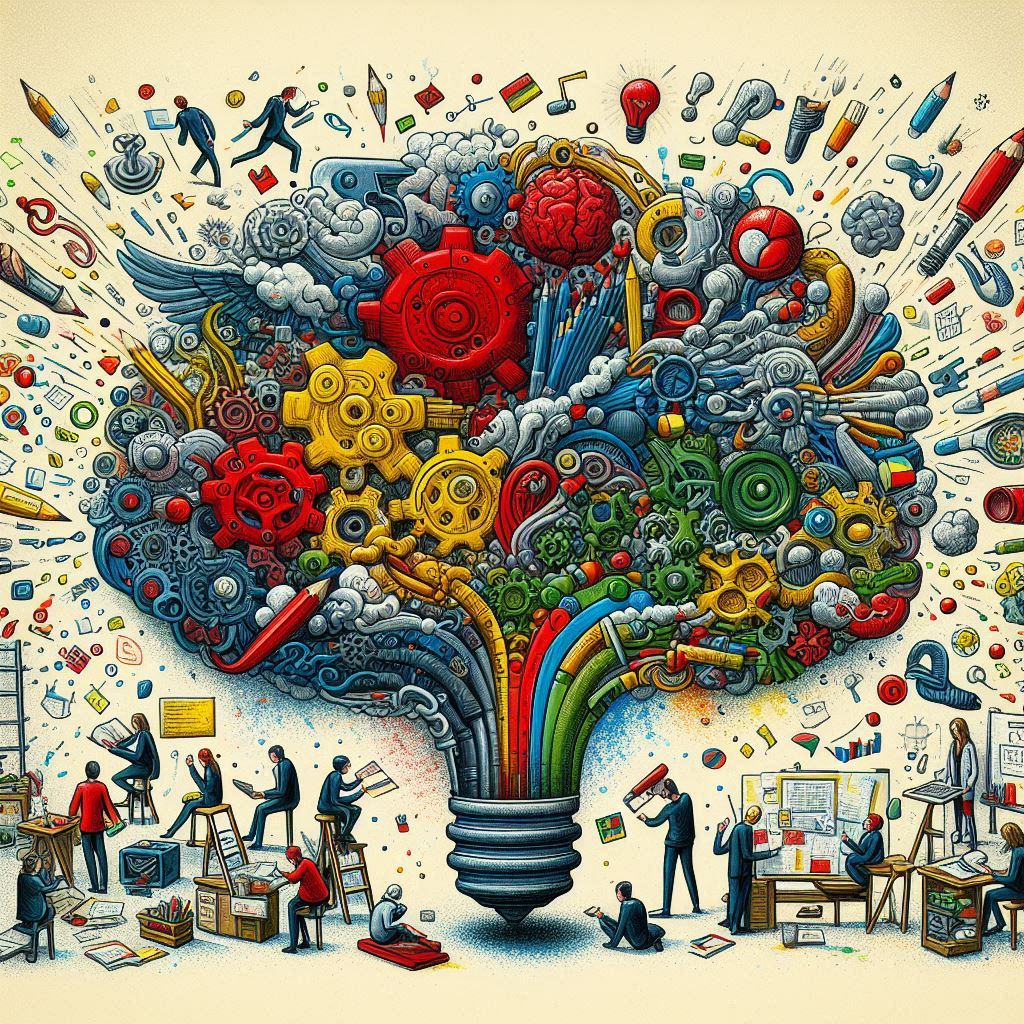Understanding The Idea Generation Process
Generating ideas lies at the heart of human inventiveness and problem-solving agility. This article delves deeply into the phases of the ideation process, underscoring its significance and offering practical guidance on how to boost creative thinking abilities. We will explore idea-generation techniques, understand their applications, and how they foster innovation within various organizational contexts.
The Significance of Idea Generation
Definition of Idea Generation
The ideation process is a holistic approach to creating and cultivating unique problem-solving tactics suited to various challenges. Key elements that steer successful ideation include an in-depth understanding of the problem, empathy towards the target audience’s needs, cultivating an atmosphere that encourages creativity, active participation of key stakeholders, and adept management of constraints.
Tools and techniques like brainstorming, mind mapping, the SCAMPER technique, and reverse thinking can stimulate creativity, revealing hidden depths and unthought-of solutions. Augmenting these processes with digital aids such as brainstorming software and mind-mapping tools can simplify and enhance the ideation process. Crucial for organizations that value innovation, ideation can be incredibly fruitful when paired with the right tools and methodologies.
Role of Idea Generation for Business Expansion
Idea generation is a stepping stone, enabling businesses to surmount challenges and forge unique action plans. Deploying techniques like brainstorming, mind mapping, the SCAMPER technique, and reverse thinking sparks creativity, unearthing ideas that may have previously been left on the drawing board. Leveraging these methodologies can allow companies to fan the flames of innovation, sparking ground-breaking ideas of the highest caliber.
Essential Factors for Successful Idea Generation

The Issue You’re Trying to Solve
Gaining a comprehensive understanding of the issue at hand is a fundamental element in generating winning ideas. Creative techniques such as brainstorming, mind mapping, the SCAMPER technique, and reverse thinking can act as catalysts, triggering miracles of inventiveness and unveiling fresh perspectives. By deploying these techniques, companies can ignite a spark that inspires new concepts and drives innovation.
Needs of the Target Audience
Understanding your audience’s needs, preferences, and pain points can offer a wealth of insights when ideating innovative solutions. For instance, a technology company developing a new mobile device might identify a demand for longer battery life based on user feedback. A clothing brand considering sustainable alternatives might conceive ideas for eco-friendly fabric developments.
Concentrating on the target audience’s needs enables companies to conceptualize ideas that profoundly deliver value and resonate with their customers.
The Workplace Culture
Nurturing a culture that celebrates creativity within organizations is critical to uncovering cutting-edge solutions and venturing into uncharted business territory. Techniques like brainstorming, role-playing, and reverse thinking accelerate the generation of original ideas, pinpointing fresh opportunities, refining current concepts, and rejuvenating established practices.
By implementing tried and true idea-generation strategies such as creative thinking, design thinking, and sophisticated opportunity identification tactics, organizations can unlock the potential within their teams and create an environment that thrives on creativity.
Contributions of Stakeholders & Team
The generation of ideas relies on individual creativity and the collective wisdom and input of stakeholders and team members. Encouraging participation from varied perspectives and expertise can result in an explosion of innovative ideas and solutions. Involving external stakeholders such as customers, suppliers, or industry specialists can offer a fresh perspective, unveiling potential opportunities that might have been previously overlooked.
Collaboration in the ideation process fosters a sense of group ownership and increases stakeholder engagement; it incorporates diverse viewpoints, leading to more effective and innovative solutions.
Managing Constraints
Far from being a hindrance, managing constraints can be a catalyst that boosts creativity during the idea-generation process. Established boundaries provide guidance and structure to drive imagination, often leading to more innovative results. Operating under constraints compels teams to think creatively, searching for novel solutions tailored to the constraints.
For instance, a marketing team trying to reach its target audience within channel limitations might invent fresh and unique strategies. Managing constraints can, therefore, facilitate practical and focused idea generation.
Exploring the Principles of Idea Generation
Several techniques can inspire the idea generation process. The Idea Challenge method encourages a creative response to a specific problem or question, while the SCAMPER Technique helps adjust existing ideas. Opposite thinking promotes challenging time-honored assumptions, while brainstorming cards can help conjure innovative concepts. Analogy thinking applies successful solutions from one scenario to another.
By effectively utilizing these techniques and systematically evaluating ideas, organizations can significantly bolster their capacity for continuous improvement and innovation.
Stages Involved in the Idea Generation Process

Stage 1 – Compiling the Information
Compiling requisite information lays a solid foundation for ideation. Gathering extensive data and insights, such as customer feedback, market analysis, industry reports, etc., can spark new ideas, highlight recurring trends, and identify potential opportunities. A systematic approach to compiling information vital for your ideation efforts ensures that your ideas are innovative, data-driven, and impactful.
Stage 2 – Assembling Your Data
After acquiring the necessary information, structuring that data systematically provides a complete understanding of the insights gathered. Using idea management tools enables efficient collection and organization of ideas. The assembly process often involves the collaboration of individuals from diverse backgrounds, lending invaluable diversity to the ideation process and enhancing the overall quality of ideas.
Stage 3 – Putting It Aside
After embarking on an initial brainstorming session, setting your ideas aside momentarily can offer a fresh perspective. Loosening your hold on the ideas allows for a detached evaluation and refinement. This stage also paves the way for subconscious processing, often sparking connections and insights that may have been overlooked during the initial brainstorming.
Stage 4 – That ‘Aha’ moment
Following multiple stages of creativity often comes the eureka moment when a breakthrough idea surfaces. Whether designing a novel product or conceiving an innovative marketing strategy, this moment of sparkling clarity energizes the team and propels them toward successful outcomes.
Stage 5 – Communicating Your Idea
Without effective communication, even the most ground-breaking ideas can fall on deaf ears. Utilizing tools such as infographics or slideshows and techniques such as storytelling can amplify complex ideas, captivating the audience and garnering support for your innovative concepts.
Varied Techniques and Strategies for Generating Ideas
The Art of Brainstorming

Employing methods such as brainstorming, mind mapping, and the SCAMPER technique can be highly effective in stimulating the ideation process. These techniques expand the canvas of creativity and enhance the possibility of discovering unconsidered connections and correlations. Utilizing software tools during the ideation process can streamline the brainstorming session and facilitate the efficient structuring of thoughts.
Creative Thinking

Techniques that encourage creative thinking, such as the Idea Challenge, the SCAMPER technique, Opposite Thinking, Brainstorm Cards, and Analogy Thinking, enrich the ideation process. These methods broaden the arena of idea generation, kindle high-quality ideation, and cultivate an organizational culture that embraces innovation.
Design Thinking

Techniques typical of Design Thinking, such as the SCAMPER method and reverse thinking, can be pivotal during the ideation process. They enable tweaking and transforming existing ideas, challenging long-standing assumptions, and delivering unique and innovative solutions.
Technique SCAMPER

The SCAMPER technique provides a structured approach to examining ways to enhance existing ideas or procedural workflows. By incorporating this technique into their strategic thinking, organizations can introduce incremental but significant changes, leading to considerable improvements.
Thinking Oppositely

Opposite thinking extends conventional thought, prompting the exploration of unfamiliar terrain. Organizations can discover unanticipated solutions and distinguish themselves from their competitors by defying the status quo and considering strikingly contrasting scenarios.

Vizologi is a revolutionary AI-generated business strategy tool that offers its users access to advanced features to create and refine start-up ideas quickly.
It generates limitless business ideas, gains insights on markets and competitors, and automates business plan creation.


